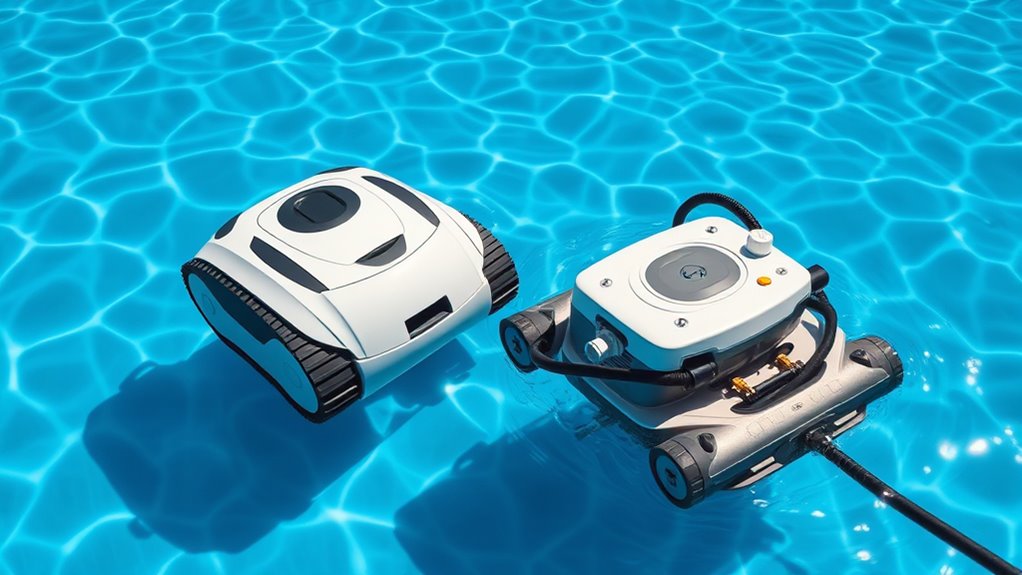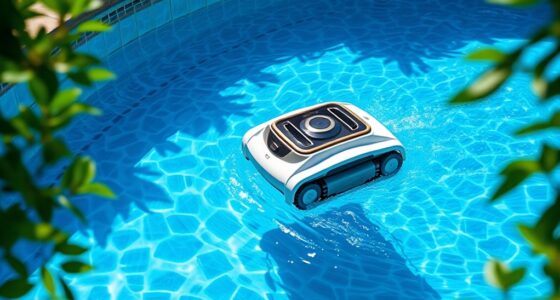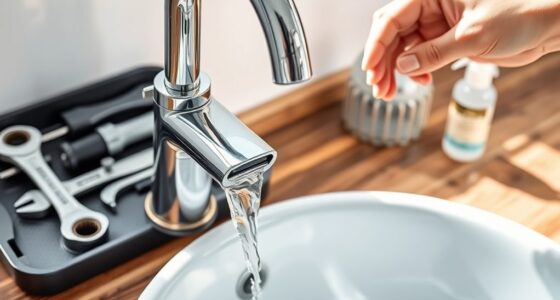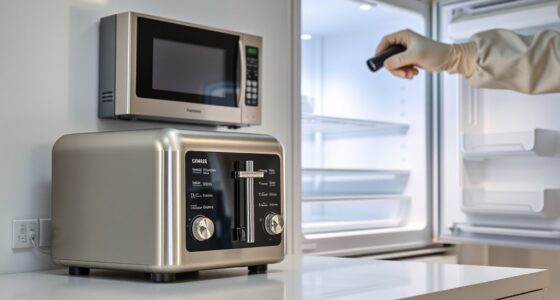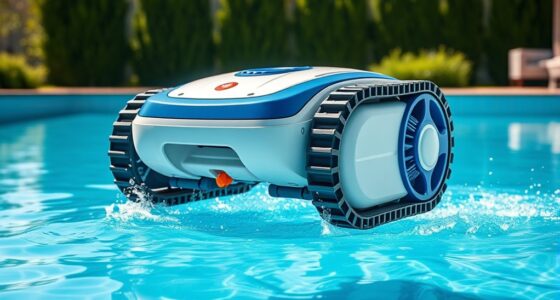Pressure pool cleaners use your pool’s pump and hoses to move and scrub surfaces, making them ideal for large pools but less precise in tight spots. Robotic cleaners operate independently with advanced sensors and mapping, delivering thorough cleaning and less effort on your part. While pressure models are usually cheaper upfront, robotic options can save energy and provide better coverage, especially in complex pools. To find out which best fits your needs, explore these differences further.
Key Takeaways
- Pressure pool cleaners use water pressure from the pool’s pump, while robotic cleaners operate independently with onboard motors and sensors.
- Robotic cleaners offer more thorough, customizable cleaning, especially in hard-to-reach areas, compared to the basic coverage of pressure cleaners.
- Pressure cleaners are generally easier and quicker to install, often at a lower initial cost, but may require more ongoing maintenance.
- Robotic cleaners tend to be more energy-efficient and environmentally friendly, with advanced navigation and mapping features.
- For large or complex pools, pressure cleaners are more powerful, but robotic models provide better coverage and automation.
How Pressure Pool Cleaners Operate
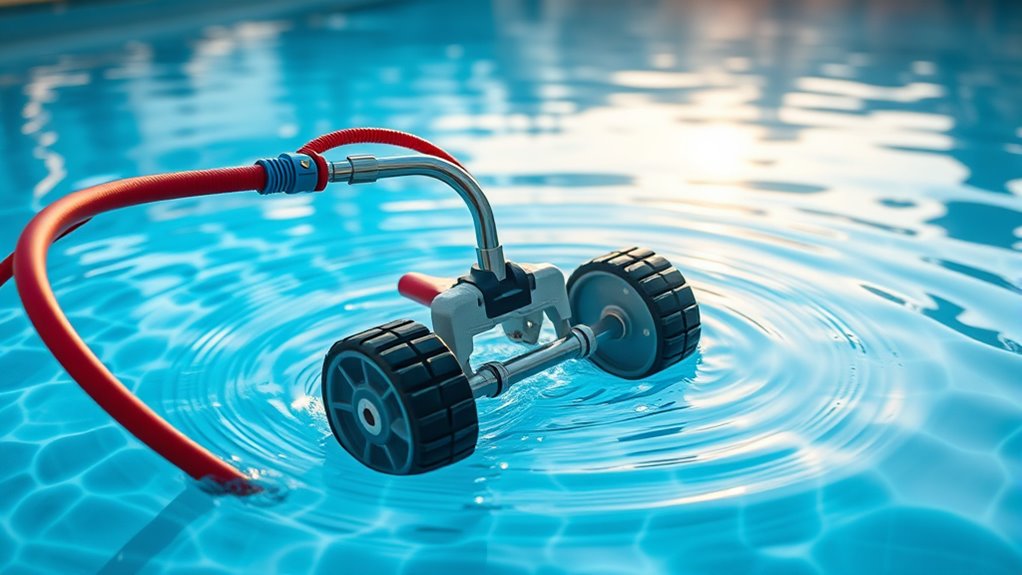
Pressure pool cleaners operate by using the pressure from your pool’s pump to power their movement and cleaning functions. The cleaner attaches to a dedicated inlet, and as the pump circulates water, it creates high pressure that propels the cleaner around your pool. Your pool size influences how effectively the cleaner covers the entire surface, as larger pools may require more powerful equipment or multiple passes. Water chemistry also plays a role; balanced water prevents debris buildup and keeps the cleaner functioning smoothly. If the water’s pH or chemical levels are off, debris can stick or clog the system, reducing efficiency. Proper maintenance of water chemistry and understanding your pool’s size ensure the pressure cleaner operates at its best, keeping your pool clean with minimal hassle. Additionally, the contrast ratio of your pool lighting can affect the visibility of debris during cleaning. Maintaining optimal water chemistry is essential for preventing debris accumulation and ensuring consistent cleaning performance, as well as avoiding clogging issues that may arise from improper chemical balance. Regular inspections and system maintenance can further enhance the cleaner’s longevity and effectiveness. Furthermore, selecting the right pressure ratings for your specific pool setup can improve cleaning efficiency and reduce strain on your equipment.
How Robotic Pool Cleaners Work
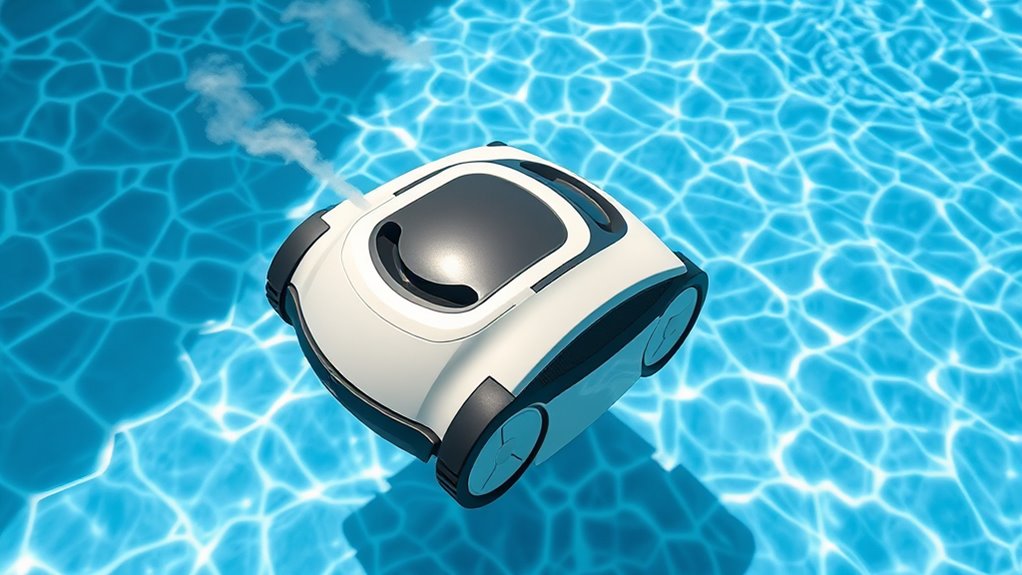
Robotic pool cleaners use advanced navigation and mapping technology to efficiently cover your pool surface. They rely on powerful cleaning mechanisms to scrub and vacuum dirt from the floor, walls, and waterline. Understanding how these features work together helps you see why they’re often more effective than pressure models. Additionally, embracing failure as part of the learning process can lead to more innovative cleaning solutions and improvements in robotic technology. Such innovations often involve tuning the cleaning algorithms to adapt better to different pool shapes and debris types. Continuous advancements in navigation systems further enhance the efficiency and coverage of robotic pool cleaners, enabling them to better mimic human-like movement patterns for thorough cleaning.
Navigation and Mapping
While robotic pool cleaners are designed to efficiently navigate your pool, understanding how they map and move around is key to appreciating their effectiveness. These cleaners rely on advanced sensor technology to detect walls, obstacles, and water features, allowing them to create a mental map of your pool’s layout. This mapping helps them determine the most efficient cleaning path, avoiding redundant coverage. This process often involves sensor technology that detects environmental features to optimize movement. The user interface of your robotic cleaner often displays real-time navigation data, giving you insight into its progress and areas covered. Some models even adapt their routes based on sensor feedback, ensuring thorough cleaning. By combining sensor technology with an intuitive interface, these robots optimize their movement, saving you time and effort while maintaining a sparkling clean pool. Additionally, mapping technology enhances the robot’s ability to adapt to different pool shapes and sizes for comprehensive cleaning coverage. Modern robotic pool cleaners also use smart navigation algorithms to improve their efficiency and coverage area. Furthermore, environmental sensing allows the robot to adjust its cleaning strategy based on water conditions or debris levels, making it even more effective. A powerful motor can also improve cleaning performance by increasing suction and brush action, ensuring thorough debris removal.
Cleaning Mechanisms
Robotic pool cleaners leverage a combination of brushes, vacuums, and filters to thoroughly clean your pool’s surfaces. They scrub walls, floors, and waterlines while collecting debris in their filters, guaranteeing a spotless pool. User convenience is key, as these cleaners operate automatically and require minimal supervision. Regular filter maintenance is essential for peak performance; cleaning or replacing filters prevents clogs and maintains suction power. Their cleaning mechanisms work efficiently, saving you time and effort compared to manual cleaning. Here’s a quick overview:
| Feature | Benefit | Maintenance Tip |
|---|---|---|
| Brushes | Scrubs surfaces effectively | Check for wear |
| Vacuum | Picks up debris | Empty filter regularly |
| Filters | Trap dirt and particles | Clean filters weekly |
| Navigation System | Ensures thorough coverage | Keep sensors clean |
| User Convenience | Easy to operate | Follow user manual |
Additionally, automatic cleaning systems are designed to optimize coverage and efficiency, making them a popular choice for modern pool maintenance. Regularly inspecting and updating cleaning mechanisms can further enhance their performance and longevity. For optimal results, understanding the working principles behind these devices can help troubleshoot issues and improve their lifespan.
Cost Comparison Between the Two Types

When comparing the costs of pressure pool cleaners and robotic models, it’s important to contemplate both initial investment and ongoing expenses. Pricing models vary: pressure cleaners typically have a lower upfront cost, making them more budget-friendly initially. Robotic cleaners tend to be pricier at purchase but often include features that reduce maintenance costs over time. Warranty coverage also plays a role; robotic models usually come with longer or more extensive warranties, providing peace of mind and potential savings on repairs. Additionally, robotic cleaners often require less manual intervention, saving you time and effort. While pressure cleaners may seem cheaper upfront, consider long-term costs such as replacement parts, energy use, and maintenance when making your decision. Incorporating efficient equipment can further influence overall operational expenses.
Ease of Installation and Setup
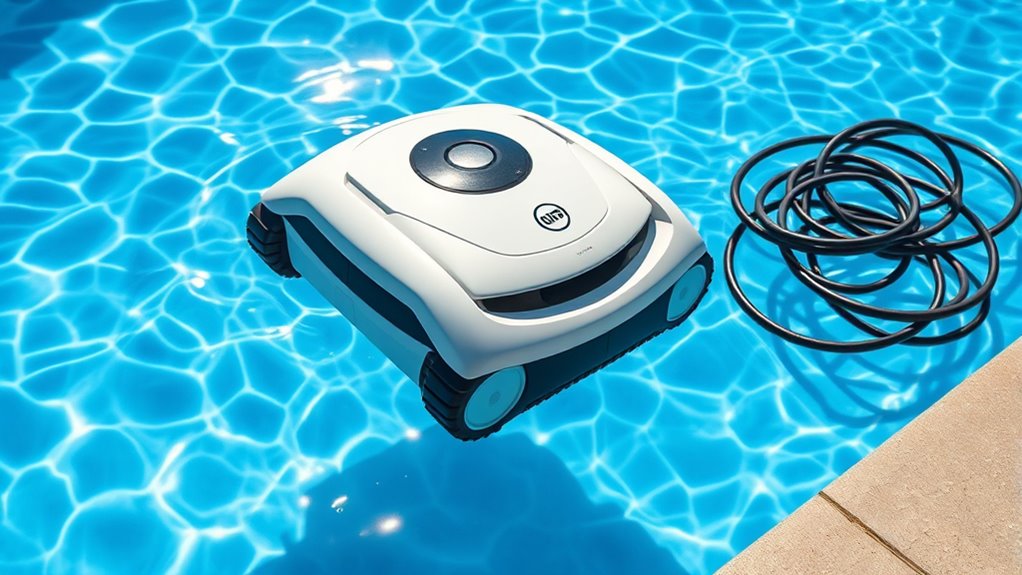
Installing and setting up pressure pool cleaners is generally straightforward, often requiring only basic tools and minimal technical knowledge. The installation complexity is low, making it easy for most pool owners to handle without professional help. These cleaners typically connect directly to the existing skimmer or return line, which simplifies the setup process. Their user friendliness means you can get them running quickly without fuss. Most models come with clear instructions and simple attachments, reducing the time needed for setup. Unlike some robotic cleaners, pressure models don’t require complicated wiring or programming, making them accessible even for beginners. Additionally, their installation process often involves minimal tools and effort, further easing setup. Their design simplicity means less troubleshooting and maintenance over time. Moreover, understanding the differences between pressure and robotic cleaners can help you choose the best option for your needs. Considering the potential for ease of installation to reduce setup frustrations, pressure cleaners are a popular choice among pool owners. Overall, their ease of installation and straightforward setup process ensure you’ll spend less time on preparation and more on enjoying your clean pool.
Cleaning Efficiency and Coverage
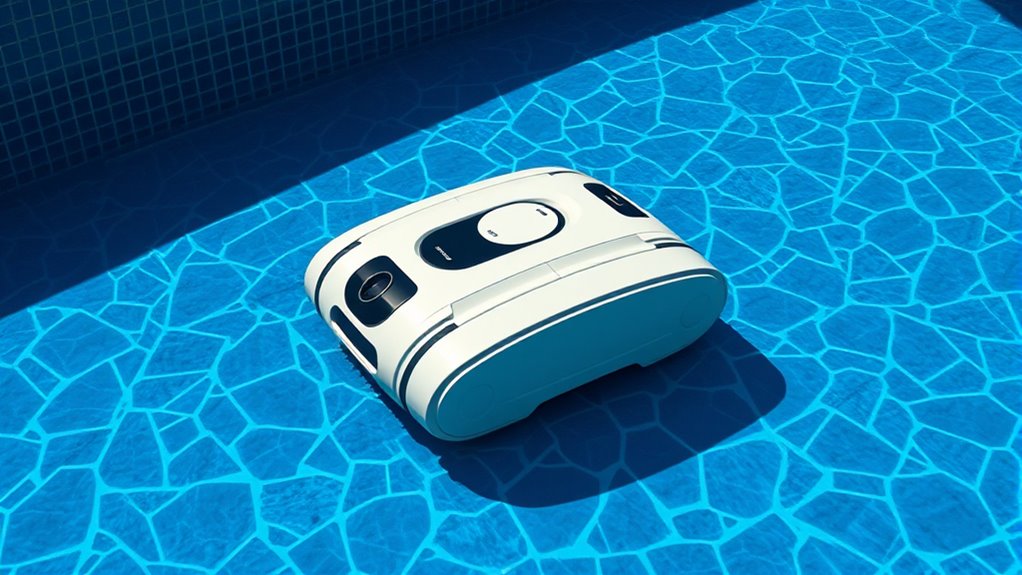
Pressure pool cleaners are known for their effective cleaning performance, but their coverage can vary depending on the model and pool layout. Larger pools or irregular shapes may challenge their ability to reach every corner, so pool size considerations are vital. If your pool is extensive, you might notice some areas left untouched, affecting overall cleanliness. User experience factors also come into play; a cleaner that requires frequent repositioning or doesn’t adapt well to obstacles can be frustrating. Additionally, the water pressure supply influences cleaning efficiency, so proper setup is essential. While pressure cleaners excel at removing dirt from floors and walls, their coverage might not be as all-encompassing as robotic models, especially in complex or sizable pools. Choosing the right cleaner depends on balancing these factors for top results.
Maintenance and Longevity
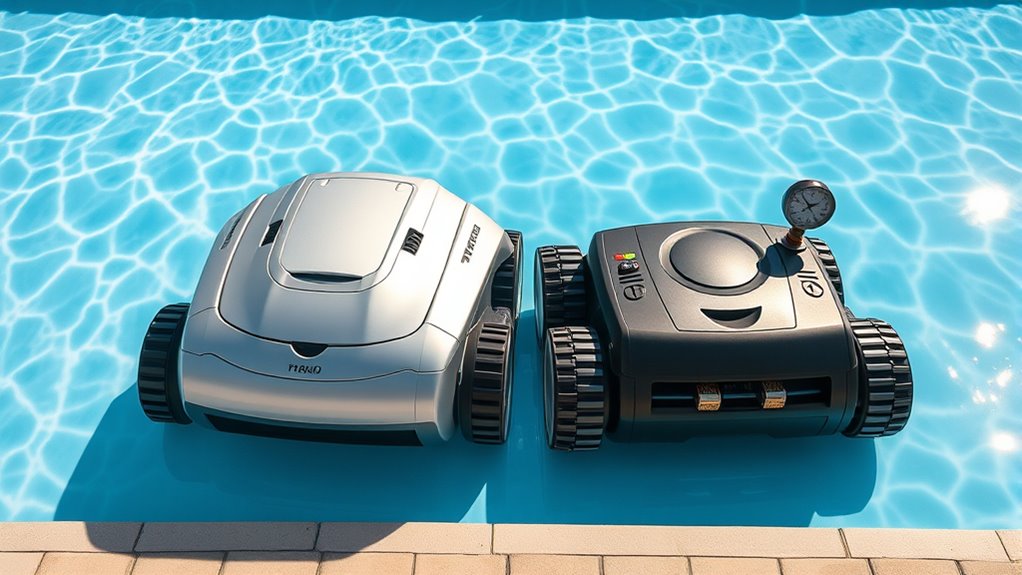
Proper maintenance is essential to keep pressure pool cleaners functioning effectively and extend their lifespan. Regular filter maintenance ensures debris doesn’t clog the system, preventing strain on the cleaner’s motor. Clean the filter basket weekly and replace filters as needed to maintain ideal water flow. This helps preserve motor durability by reducing unnecessary wear and tear. Check hoses and connections for leaks or damage, and replace worn parts promptly. Keep an eye on the cleaner’s brushes and tracks, replacing them when they show signs of excessive wear. Proper storage during the off-season also prolongs longevity, protecting components from UV damage and corrosion. Additionally, Asset division during a divorce can impact your financial stability and influence your ability to afford proper pool maintenance post-divorce. Consistent maintenance not only improves performance but also saves you money by avoiding costly repairs and replacements. Additionally, appliance maintenance practices can help identify potential issues early, ensuring your pool cleaner remains in optimal condition longer. Being aware of cost-effective strategies can also help you manage expenses related to pool upkeep effectively.
Energy Consumption and Operating Costs
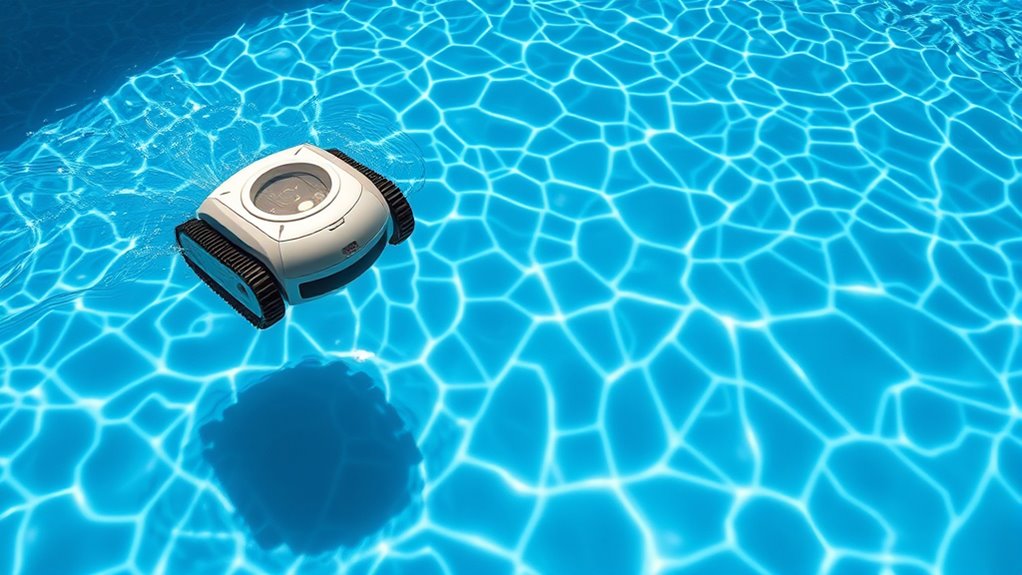
Robotic pool cleaners generally consume less energy than traditional pressure models, which can lead to significant savings on your operating costs over time. Their efficient design means lower power consumption, reducing your electricity bills without sacrificing cleaning performance. Because they operate independently of your pool’s filtration system, they use less energy overall. This improved cost efficiency makes robotic cleaners a smart investment for long-term savings. Additionally, many models have programmable timers and energy-saving features that further cut down on power use. By choosing a robotic cleaner, you’ll enjoy cleaner pools with less energy expenditure. Over time, these energy savings offset the initial purchase price, making robotic cleaners a more economical choice compared to pressure models that tend to be less efficient in terms of power consumption.
Ideal Pool Types for Each Cleaner
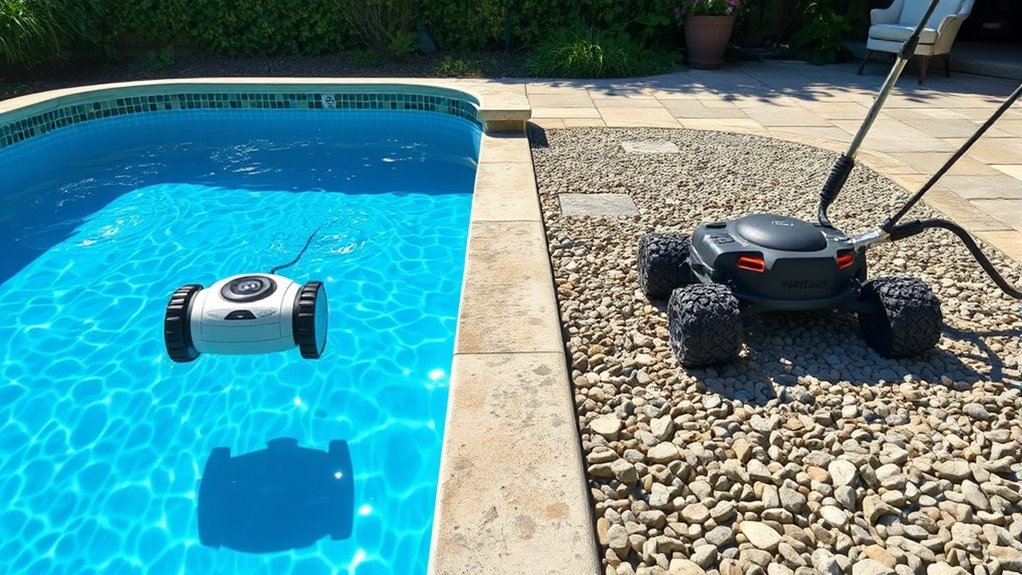
Choosing the right pool cleaner depends heavily on your pool’s size, shape, and environment. For larger pools, pressure cleaners work well because they can cover extensive areas efficiently, making them ideal for pools with complex layouts or irregular shapes. They handle debris from bigger surfaces, especially in pools with plenty of corners or steps. Robotic cleaners are better suited for small to medium-sized pools, where their precise navigation and advanced filtering provide a thorough clean. Aesthetic design factors also matter; if your pool features sleek lines or intricate designs, a robotic cleaner’s ability to adapt to diverse shapes ensures a cleaner finish. Ultimately, matching your pool’s size and aesthetic elements with the cleaner’s capabilities helps optimize performance and maintain your pool’s beauty.
Environmental Impact and Sustainability

When choosing between pressure and robotic pool cleaners, consider how their energy use impacts the environment. Robotic cleaners often consume less power, making them more eco-friendly in the long run. Additionally, many models now use sustainable materials, reducing your pool’s overall environmental footprint.
Energy Consumption Differences
While both pressure and robotic pool cleaners consume energy, their efficiency and environmental impact differ markedly. Robotic cleaners typically offer better energy savings because they use less power for targeted cleaning. They rely on low-voltage motors and operate with precise, programmed movements, reducing unnecessary energy use. In contrast, pressure cleaners often require more power due to their reliance on existing pool pump systems, which tend to have higher power usage. This means pressure cleaners can draw more electricity over time, increasing energy costs and environmental footprint. If minimizing energy consumption is a priority, robotic cleaners generally prove more sustainable. They are designed to operate efficiently, helping you save on energy bills while reducing your pool’s overall environmental impact.
Eco-Friendly Material Use
Robotic pool cleaners often incorporate eco-friendly materials that reduce their environmental impact throughout their lifecycle. Many models use recyclable plastics, which can be remanufactured and reused, minimizing waste. Additionally, some manufacturers opt for biodegradable materials in parts that are prone to wear or replacement, ensuring these components break down more quickly after disposal. By choosing robots with these sustainable materials, you’re supporting a greener approach to pool cleaning. This focus on eco-friendly construction not only lowers the carbon footprint but also reduces reliance on non-renewable resources. As a result, you help promote environmental conservation while enjoying a cleaner pool. Overall, the use of recyclable plastics and biodegradable materials makes robotic cleaners a more sustainable choice for eco-conscious pool owners.
Which Cleaner Suits Your Pool Maintenance Needs
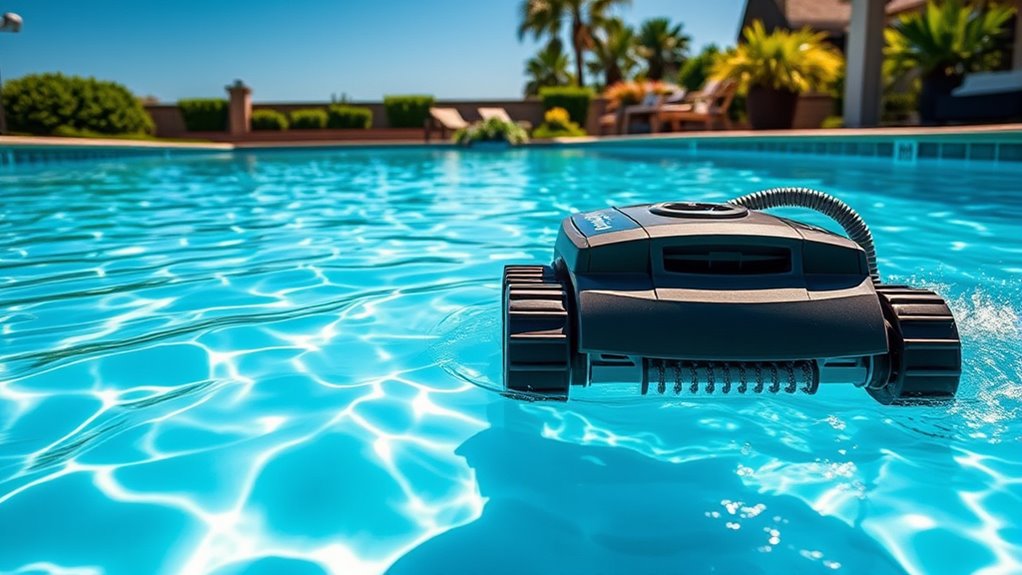
Choosing the right pool cleaner depends on your specific maintenance needs and the features of your pool. Your pool size plays a pivotal role—larger pools may require more efficient cleaning solutions, while smaller pools can be handled by simpler devices. Consider your user preferences too; if you want minimal effort, robotic cleaners often offer automatic operation and easy maintenance. On the other hand, pressure cleaners might be suitable if you prefer a more hands-on approach or already have a compatible pump. Think about the debris type and frequency of cleaning needed. By evaluating these factors, you can select a cleaner that fits your pool’s size and your lifestyle, ensuring a cleaner pool with less hassle and more enjoyment.
Frequently Asked Questions
Which Cleaner Is Better for Large or Irregularly Shaped Pools?
For large or irregularly shaped pools, you need a cleaner that handles diverse shapes and sizes effectively. Consider your pool size and shape compatibility to choose the best option. Robotic cleaners often excel in maneuvering complex shapes and covering large areas thoroughly. They are designed to adapt to different pool contours, making them ideal for irregular pools. Pressure cleaners can also work well but may require more setup for irregular shapes.
How Do Weather Conditions Affect Cleaner Performance?
Weather impact considerably influences pool cleaners’ performance, especially with climate considerations. Heavy rain can overwhelm some cleaners, causing them to miss spots or get stuck. Wind can blow debris into your pool, increasing cleaning frequency. Sun exposure might degrade certain parts over time. You should regularly check your cleaner after storms or extreme weather, and choose a model suited for your climate to guarantee ideal performance year-round.
Can Pressure and Robotic Cleaners Be Used Together?
You can definitely use pressure and robotic cleaners together for dual cleaning, which enhances overall pool maintenance. This combo ensures thorough debris removal and improves energy efficiency since each cleaner targets different areas and types of dirt. By combining their strengths, you save time and effort, maintaining a cleaner pool more effectively. Just make sure your pool’s system can handle both devices simultaneously for peak performance and energy savings.
What Safety Precautions Are Necessary During Cleaner Operation?
During cleaner operation, you need to follow safety protocols and operational guidelines to prevent accidents. Always turn off power before handling the cleaner, avoid touching moving parts, and keep children and pets away. Make sure cords are secured and water is turned off if necessary. Regularly inspect equipment for damage, and never operate the cleaner in bad weather. Following these precautions guarantees safe and efficient cleaning sessions.
Are There Specific Maintenance Tips for Extending Lifespan?
Think of your cleaner as a well-oiled machine—regular maintenance keeps it running smoothly. To extend its lifespan, stay on top of filter maintenance to prevent clogs and guarantee peak cleaning. Also, give the motor proper care by inspecting for debris and avoiding overworking it. Regularly check brushes and seals, and store the cleaner in a shaded area when not in use. These steps help your cleaner stay in top shape longer.
Conclusion
Choosing between pressure and robotic pool cleaners depends on your pool’s needs and your preferences. Think of it as finding the perfect dance partner—each has its rhythm and style. Pressure cleaners are great for quick, powerful scrubbing, while robotic ones offer precision and convenience. Whichever you pick, it’s about making pool maintenance a breeze, turning a chore into a smooth swim. Immerse yourself confidently, knowing your choice keeps your pool sparkling like a gem.
